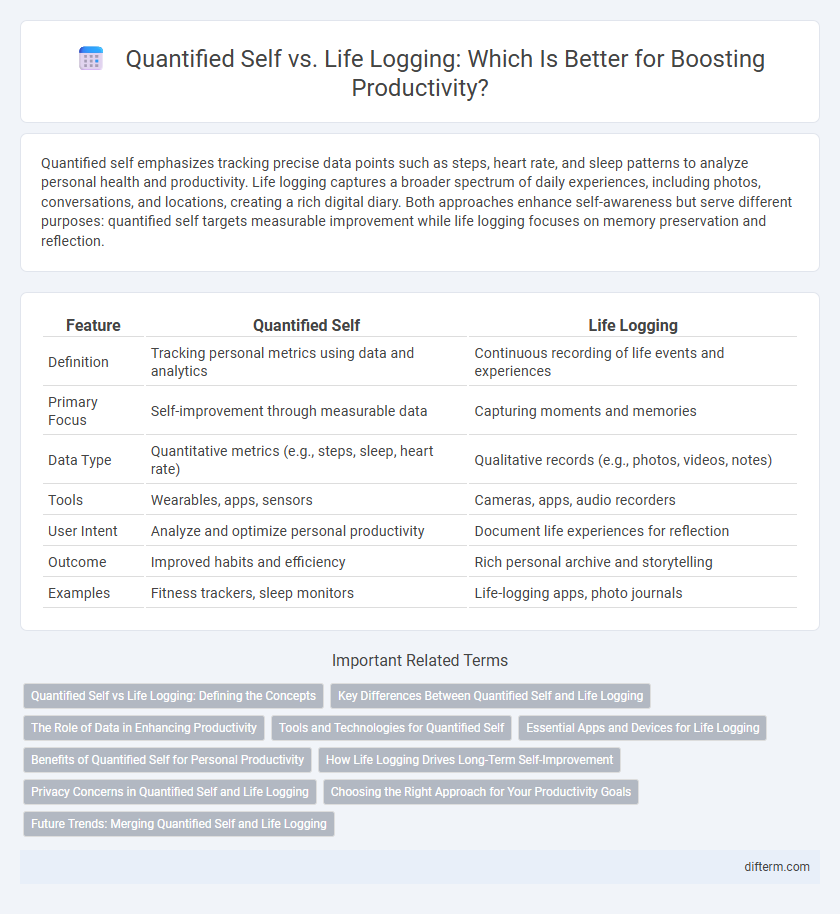Quantified self emphasizes tracking precise data points such as steps, heart rate, and sleep patterns to analyze personal health and productivity. Life logging captures a broader spectrum of daily experiences, including photos, conversations, and locations, creating a rich digital diary. Both approaches enhance self-awareness but serve different purposes: quantified self targets measurable improvement while life logging focuses on memory preservation and reflection.
Table of Comparison
| Feature | Quantified Self | Life Logging |
|---|---|---|
| Definition | Tracking personal metrics using data and analytics | Continuous recording of life events and experiences |
| Primary Focus | Self-improvement through measurable data | Capturing moments and memories |
| Data Type | Quantitative metrics (e.g., steps, sleep, heart rate) | Qualitative records (e.g., photos, videos, notes) |
| Tools | Wearables, apps, sensors | Cameras, apps, audio recorders |
| User Intent | Analyze and optimize personal productivity | Document life experiences for reflection |
| Outcome | Improved habits and efficiency | Rich personal archive and storytelling |
| Examples | Fitness trackers, sleep monitors | Life-logging apps, photo journals |
Quantified Self vs Life Logging: Defining the Concepts
Quantified Self emphasizes data-driven self-tracking through metrics like heart rate, sleep patterns, and productivity levels to optimize performance and health. Life Logging captures a broader spectrum of daily experiences, including photos, videos, and social interactions for personal memory preservation. While both involve self-monitoring, Quantified Self prioritizes analytics and measurable insights, whereas Life Logging centers on comprehensive digital documentation.
Key Differences Between Quantified Self and Life Logging
Quantified Self emphasizes collecting and analyzing personal data such as sleep patterns, physical activity, and biometrics to improve health and productivity, relying on precise measurements and metrics. Life Logging involves continuously recording daily experiences and activities through photos, videos, and journals to create a comprehensive digital memory, focusing more on qualitative data capture than quantitative analysis. The key difference lies in Quantified Self's data-driven approach for optimizing performance versus Life Logging's narrative-driven capture for reflection and memory preservation.
The Role of Data in Enhancing Productivity
Quantified self leverages precise, personal data such as biometric and activity metrics to optimize productivity by enabling tailored goal setting and performance analysis. Life logging captures continuous, comprehensive digital records of daily experiences, providing broader context and patterns that inform time management and decision-making strategies. Integrating these data-driven approaches enhances self-awareness and efficiency, empowering individuals to make informed adjustments and improve overall productivity.
Tools and Technologies for Quantified Self
Quantified self relies heavily on advanced wearable devices like smartwatches, fitness trackers, and biometric sensors to collect precise data on physical activity, sleep patterns, and health metrics. Mobile apps and cloud platforms enable real-time monitoring and detailed analysis, enhancing personalized productivity insights. Machine learning algorithms and AI-driven analytics optimize data interpretation, facilitating actionable steps for improved efficiency and well-being.
Essential Apps and Devices for Life Logging
Essential apps and devices for life logging include wearable fitness trackers like Fitbit and Apple Watch that continuously monitor health metrics such as heart rate, sleep patterns, and activity levels. Mobile apps like Day One and Journey enable detailed journaling and photo logging, capturing daily experiences with timestamps and GPS data for contextual insights. Smart home devices and voice assistants further enhance life logging by automating data collection and providing seamless integration with other productivity tools.
Benefits of Quantified Self for Personal Productivity
Quantified Self leverages precise data tracking of physical, mental, and behavioral metrics to optimize personal productivity through informed decision-making and habit refinement. By systematically measuring sleep patterns, energy levels, and task completion rates, individuals gain actionable insights that promote efficient time management and enhanced focus. This data-driven approach fosters accountability, goal alignment, and continuous performance improvement beyond traditional life logging methods.
How Life Logging Drives Long-Term Self-Improvement
Life logging systematically records daily activities, creating a comprehensive digital archive that reveals long-term behavior patterns and trends. This extensive data enables users to identify consistent habits, monitor progress, and make informed adjustments to optimize productivity over months and years. Unlike the Quantified Self's focus on specific metrics and short-term goals, life logging supports sustained self-awareness and incremental improvement through continuous reflection on accumulated information.
Privacy Concerns in Quantified Self and Life Logging
Quantified Self and Life Logging technologies often collect extensive personal data, raising significant privacy concerns related to unauthorized access and data misuse. Users risk exposing sensitive health and behavioral information, necessitating robust encryption and strict data-sharing policies to safeguard personal privacy. Awareness of data ownership and transparency from service providers is crucial in minimizing risks associated with these self-tracking methods.
Choosing the Right Approach for Your Productivity Goals
Quantified self emphasizes data-driven self-tracking with metrics like steps, heart rate, and sleep patterns to optimize productivity by identifying precise habits and behaviors. Life logging captures continuous experiences through photos, audio, and journaling, providing contextual insights that help reflect on daily routines and emotional states. Selecting the right approach depends on whether your productivity goals require objective performance measurement or broader self-awareness and reflective practices.
Future Trends: Merging Quantified Self and Life Logging
Future trends in productivity indicate a seamless integration of Quantified Self technologies and Life Logging methods, enhancing personalized data analytics and behavioral insights. Advanced sensors and AI-driven platforms will enable continuous tracking of physical, cognitive, and emotional states, creating comprehensive life metrics for optimized decision-making. This convergence aims to empower individuals with adaptive feedback loops, fostering sustained productivity improvements and holistic well-being.
Quantified self vs Life logging Infographic

 difterm.com
difterm.com